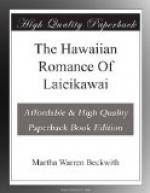(d) He may bear some relation to the sun, moon, or stars, a form rare in Hawaii, but which, when it does occur, is treated objectively rather than allegorically.
(e) He may be a god, without human kinship, either one of the “departmental gods” who rule over the forces of nature, or of the hostile spirits who inhabited the islands before they were occupied by the present race.
(f) He may be a mere ordinary man who by means of one of these supernatural helpers achieves success.
8. Poetry and prose show a quite different process of development. In prose, connected narrative has found free expression. In poetry, the epic process is neglected. Besides the formal dirge and highly developed lyric songs (often accompanied and interpreted by dance), the characteristic form is the eulogistic hymn, designed to honor an individual by rehearsing his family’s achievements, but in broken and ejaculatory panegyric rather than in connected narrative. In prose, again, the picture presented is highly realistic. The tendency is to humanize and to localize within the group the older myth and to develop later legendary tales upon a naturalistic basis. Poetry, on the other hand, develops set forms, plays with double meanings. Its character is symbolic and obscure and depends for its style upon, artificial devices.
9. Common to each are certain sources of emotional Interest such as depend upon a close interplay of ideas developed within an intimate social group. In prose occur conventional episodes, highly elaborated minor scenes, place names in profusion which have little to do with the action of the story, repetitions by a series of actors of the same incident in identical form, and in the dialogue, elaborate chants, proverbial sayings, antithesis and parallelism. In poetry, the panegyric proceeds by the enumeration of names and their qualities, particularly place or technical names; by local and legendary allusions which may develop into narrative or descriptive passages of some length; and by eulogistic comparisons drawn from nature or from social life and often elaborately developed. The interjectional expression of emotion, the rhetorical question, the use of antithesis, repetition, wordplay (puns and word-linking) and mere counting-out formulas play a striking part, and the riddling element, both in the metaphors employed and in the use of homonyms, renders the sense obscure.
PERSONS IN THE STORY
1. AIWOHI-KUPUA. A young chief of Kauai, suitor to Laie-i-ka-wai.
2. AKIKEEHIALE. The turnstone, messenger of Aiwohikupua.
3. AWAKEA. “Noonday.” The bird that guards the doors of the sun.
4. HALA-ANIANI. A young rascal of Puna.
5. HALULU-I-KE-KIHE-O-KA-MALAMA. The bird who bears the visitors to the doors of the sun.
6. HATUA-I-LIKI. “Strike-in-beating.” A young chief of Kauai, suitor to Laie-i-ka-wai.




